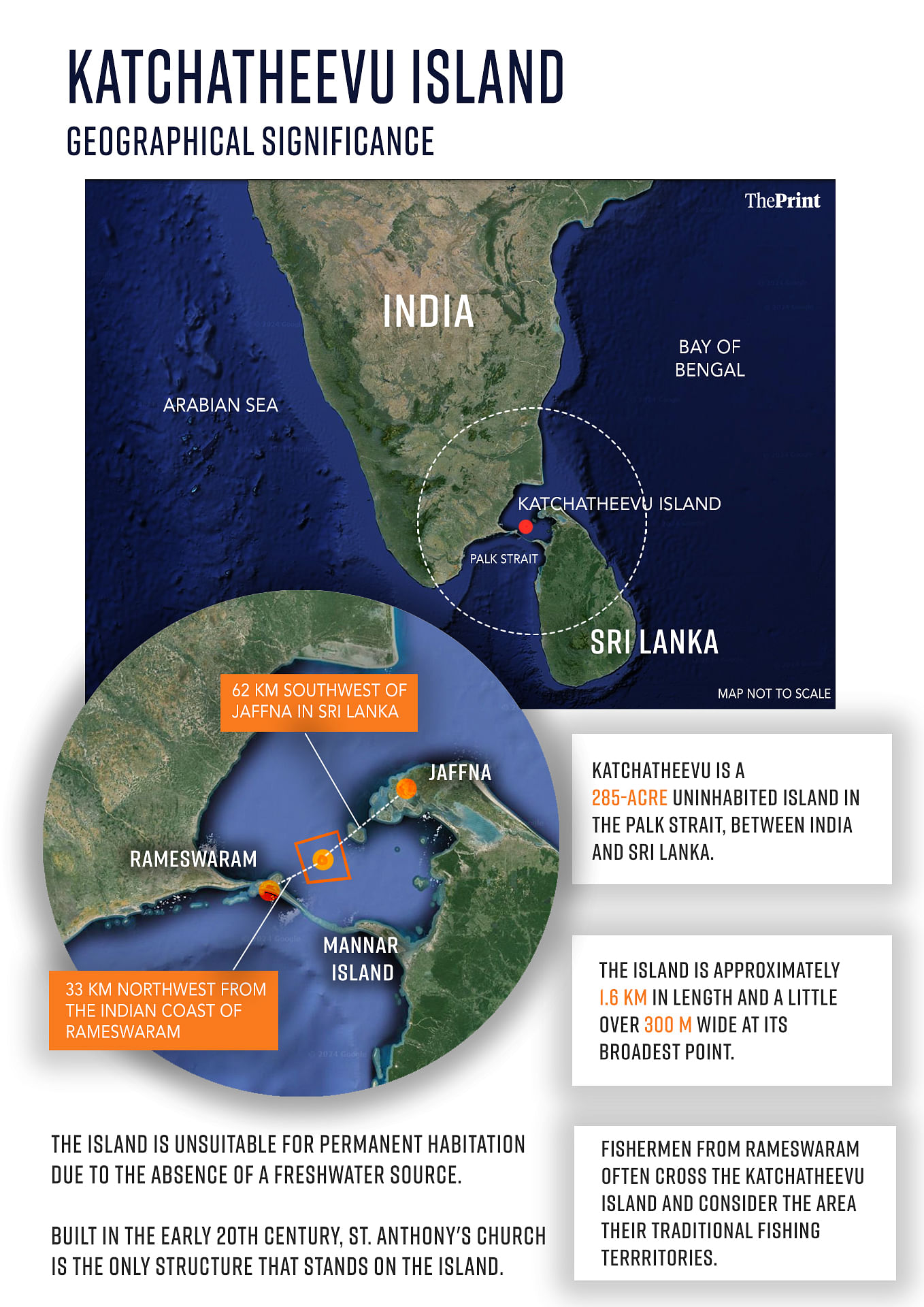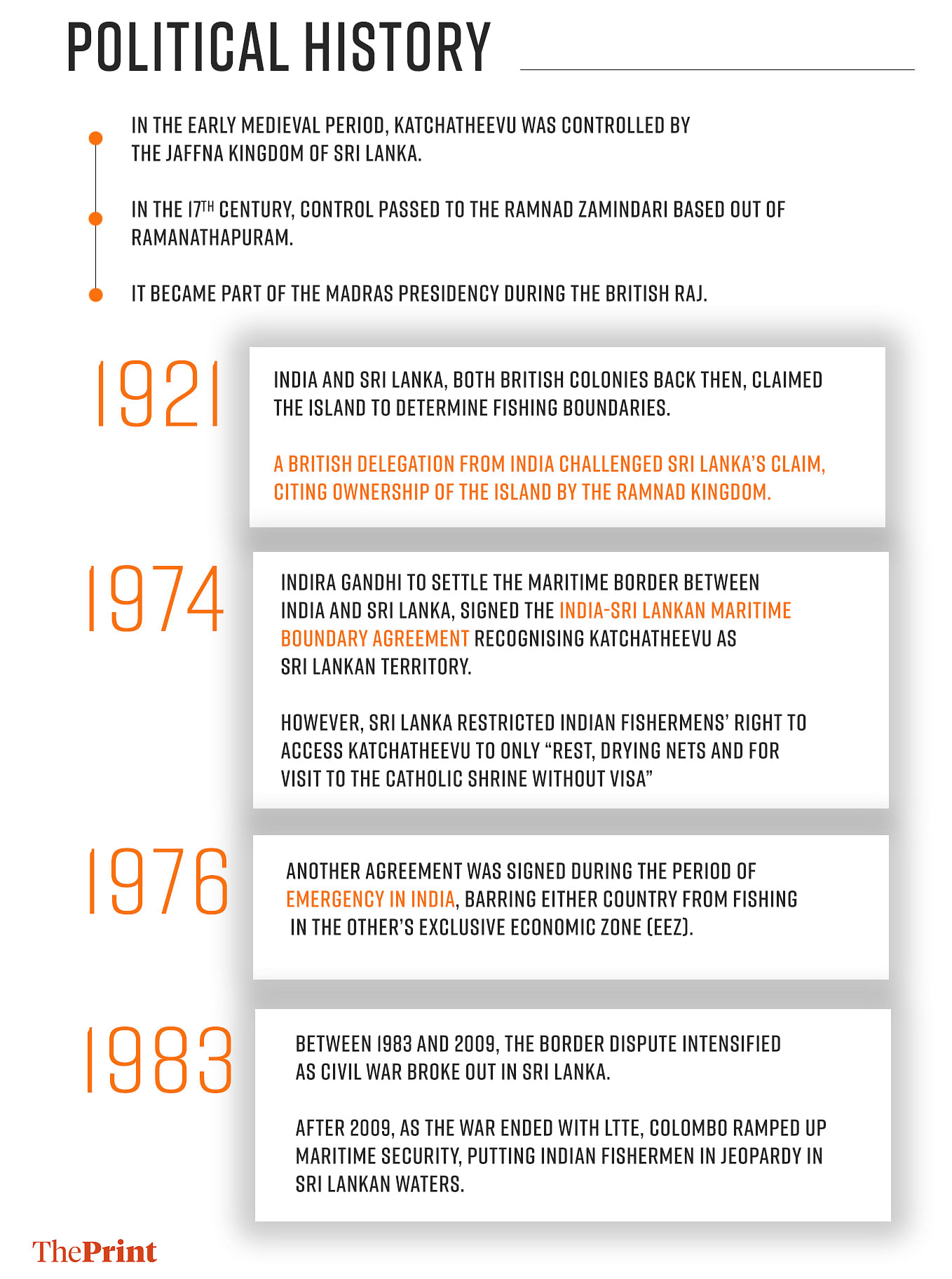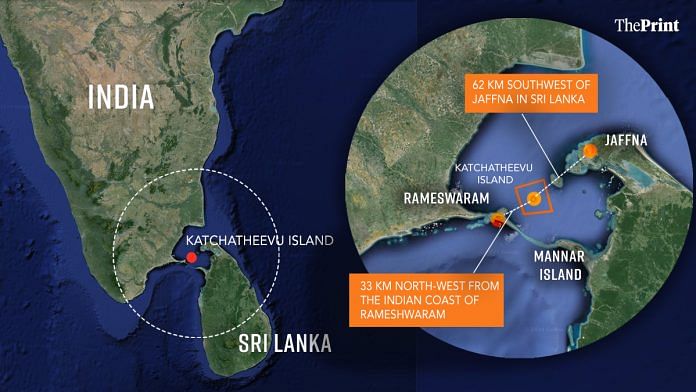New Delhi: Ahead of the Lok Sabha election, a political row has broken out over the barren and uninhabited 1.6 km-long Katchatheevu island, which India recognised as Sri Lankan territory in 1974.
The controversy erupted following a Right to Information (RTI) request filed by Tamil Nadu Bharatiya Janata Party (BJP) president K. Annamalai.
Prime Minister Narendra Modi and External Affairs Minister S. Jaishankar blamed the Congress and the Dravida Munnetra Kazhagam (DMK) for callously giving away the island.
The then prime minister Indira Gandhi signed a maritime boundary agreement with her Sri Lankan counterpart Sirimavo Bandaranaike, which recognised the island, located in the Palk Strait about 24 km north-east of Ramanathapuram in Tamil Nadu and approximately 22 km south-west of Delft Islands in Sri Lanka, as a part of Sri Lankan territory.
Modi posted on ‘X’ (formerly Twitter) that, at the time, the Congress “callously gave away” the island.
Eye opening and startling!
New facts reveal how Congress callously gave away #Katchatheevu.
This has angered every Indian and reaffirmed in people’s minds- we can’t ever trust Congress!
Weakening India’s unity, integrity and interests has been Congress’ way of working for…
— Narendra Modi (@narendramodi) March 31, 2024
On Monday, Jaishankar claimed that the Congress and the DMK are responsible for the situation where 6,184 Indian fishermen and 1,175 fishing vessels have been detained by the Sri Lankan authorities in the past two decades.
However, another 2015 RTI reply furnished by the Ministry of External Affairs (MEA) and shared by Shiv Sena (UBT) MP Priyanka Chaturvedi on ‘X’ noted that there was no “acquiring or ceding of territory belonging to India” as part of the 1974 agreement since the area in question had never been demarcated.
Maybe @MEAIndia will be able to address this discrepancies in its RTI response in 2015 vis a vis 2024.
As per the RTI response in 2015 when current Foreign Minister was serving as the FS it was said “This did not involve either acquiring or ceding of territory belonging to India… pic.twitter.com/OIWlej3YVs
— Priyanka Chaturvedi🇮🇳 (@priyankac19) April 1, 2024
ThePrint reached the MEA on the questions raised by the 2015 RTI reply via text message, but did not receive a response till the publication of this report. The report will be updated once a response is received.
Meanwhile, an analysis of the official records shows that none of the boundary agreements between India and Sri Lanka use the word “cede” with regard to territory. It merely states the latitude and longitudes that would form the maritime boundary between India and Sri Lanka. ThePrint explains the history behind Katchatheevu island.
Also Read: ‘Callously gave away isle’ — Modi invokes Katchatheevu, Congress calls it ‘distortion of history’
History of Katchatheevu
On Sunday, Annamalai publicly discussed documents obtained through the RTI reply, which contains two documents — a backgrounder prepared by the MEA in 1968 and a record of discussion of a meeting between the then foreign secretary and the chief minister of Tamil Nadu, M. Karunanidhi. ThePrint has accessed the RTI reply.

The island is home to the St. Anthony’s Church — administered by the diocese of Jaffna in Sri Lanka. The question of ownership first arose in 1921 at a conference on fishing rights held between the representatives of the government of Madras and the then Ceylon administration.
The British Raj at the time approved the Ceylonese claim to the island “subject to the zamindari rights of the Raja of Ramnad — who claimed to own the rights to the island,” the backgrounder by the MEA published in 1968 noted.
The MEA noted that the proceedings of the conference appeared to have been forwarded to the admiralty in the UK, which raised objections at the time and, therefore, was not ratified by the then Government of India.
The Ceylon administration, however, maintained de facto control of the island.
The issue arose between the two neighbours when soon after Independence, the Indian Navy “intimated” to Colombo its intention of holding exercises on the island.

Ceylon at the time had stated that “prior” permission was required, and the Indian exercises were not held.
In 1955, the administration in Ceylon intimated its intention of running gunnery exercises on the island to New Delhi — again bringing the issue to the notice of the Government of India.
At the time, the MEA noted that the then Attorney General of India M.C. Setalvad indicated in an opinion that sovereignty over the island is in favour of it being a part of India.
The MEA’s legal department in 1960 noted that there exists a legal case for India, but at the least, the government should focus on obtaining fishing rights “around the island”.
At the time, the dispute surrounding the sovereignty of the island was not solved due to the internal situation in Sri Lanka, noted the then Commonwealth secretary Y.D. Gundevia in the MEA backgrounder.
Maritime boundary agreements with Sri Lanka
In 1974, India recognised Katchatheevu as a part of the territory of Sri Lanka under a maritime boundary agreement signed by Indira Gandhi and Bandaranaike.
The agreement looked at the waters from Adam’s Bridge to Palk Strait. Article 5 of the agreement, however, ensured that Indians could visit Katchatheevu without any requirement of a travel document, such as a visa.
Article 4 of the agreement highlighted that both countries shall “have sovereignty” and “exclusive jurisdiction” over the waters, islands, the continental shelf and sub-soil based on the demarcated line, which put the island of Kathchatheevu in Sri Lankan territory.
A follow-up agreement in 1976 on the boundaries of the Gulf of Mannar and the Bay of Bengal has a similar clause, but makes no mention of the right of Indians to visit Katchatheevu without the requirement of a travel document.
Article 5 of the 1976 agreement stated, “Each party shall have sovereign rights and exclusive jurisdiction over the continental shelf and the exclusive economic zone as well as their resources, whether living or non-living, falling on its side of the aforesaid boundary.”
Tamil Nadu wanted island back
In 1991, the Tamil Nadu assembly adopted a resolution demanding the retrieval of Katchatheevu.
In 2008, the then Tamil Nadu chief minister J. Jayalalithaa approached the Supreme Court, claiming that the two boundary agreements between India and Sri Lanka were unconstitutional, and to nullify the agreements.
In his 2008 speech, the then Sri Lankan foreign minister Rohitha Bogollagama made it clear that any nullification of the agreements by the Supreme Court of India would not be binding on his country.
At the hearing of petitions requesting the Supreme Court’s intervention to facilitate the release of arrested Indian fishermen, Attorney General Mukul Rohatgi had told the top court in 2014 that it was impossible to retrieve the island from Sri Lanka. “To retrieve it now, we have to go to war,” he had said.
(Edited by Richa Mishra)
Also Read: ‘Sri Lankan govt takes our boats, arrests our men’ — why TN fishermen boycotted Katchatheevu fest



